#Soil Health
Explore tagged Tumblr posts
Text
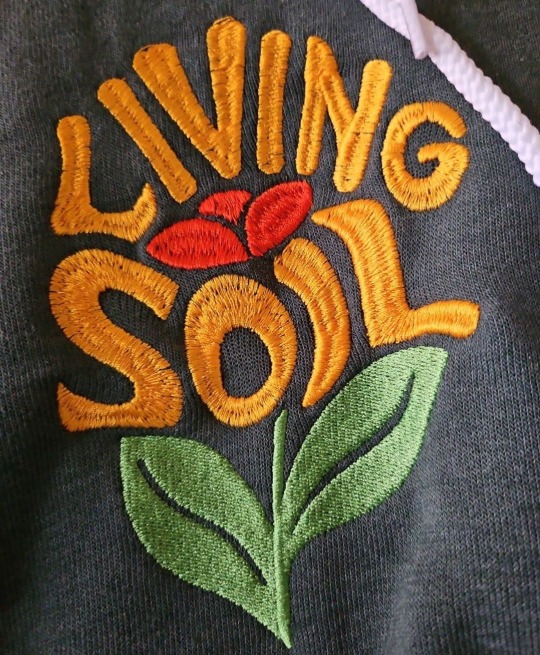

🌱✨️ "Living Soil" Embroidered Crewnecks & Hoodies ✨️🌱
Stay cozy while supporting soil health and sustainable farming 💚💛❤️
🌟 when you sign up for email offers and updates on our website, you get a chance to win up to 50% OFF your order!
🌟 FREE SHIPPING for orders over $50!!!
#soil health#soil science#soil#permaculture#environmental education#enviroment art#regenerative agriculture#regenerative farming#agriculture#sustainable living#sustainable farming#sustainability#organic life#organic matter#organic lifestyle#organic farming#organic#compost lifestyle#composting#compost#vermicompost#biodiversity#ecomindset#conservation#microbes#plant life#plant lover#street style#hippie#stoner society
535 notes
·
View notes
Text
A new study demonstrates that invasive plants don't just directly compete with native species at a direct, macro level, but the ability they have to connect with mycorrhizal partners have a negative impact on the soil microbiome into which they are introduced. It also makes the point that the relationship between a plant and its mycorrhizal partners does not occur in a vacuum, but within the wider community of plants and the various beings in the soil microbiome.
All of this may seem common sense; after all, all of nature is interconnected in some way or another. However, mycorrhizal relationships are often presented in a 1:1 ratio, with a plant and its fungal partner working together in spite of whatever else is going on around them. It should come as no surprise that environmental factors can alter that relationship, and how effectively the partners exchange nutrients. In this case in particular, the invasive plant was able to tap into the mycorrhizal network, but less efficiently than its native neighbors.
Whether it can evolve more effective connections with soil fungi in the future remains to be seen. Moreover, this was a study done in a laboratory setting with two native plants and one invasive, and may not necessarily reflect the complexity of mycorrhizal networks in nature. Still, the fact that the introduction of a non-native plant species can affect how native plants and fungi interact is one more reason to remove invasive species whenever possible.
*"Myco" means fungus and "rhizo" means root. Some soil fungi wrap their mycelium around the roots of plants, or even grow into those roots. the plants then send carbon made from sunlight through photosynthesis down to the fungi, and the fungi give the plants phosphorus and other nutrients from the soil in a mutually beneficial relationship.
#plants#fungi#mycorrhizal fungi#invasive species#invasive plants#native plants#ecology#restoration ecology#nature#botany#mycology#soil#soil science#soil health#science#scicomm#environment#conservation
131 notes
·
View notes
Text
We have had 3 hard frosts and the veggies still pull through. It pays to save your seeds as seeds have a memory.
Booking tours now through mid April 2025.

#visionarygrowingsolutions#compost#atlanta urban ag#simplefoodsmallfarmz#winter growing#atlanta airbnd experience#air bnb experience atlanta#biodynamic#soil#biodiversity#permaculture#urban ag#food systems#soil health#simple food small farmz air bnb agriculture experience#atlanta air bnb urban agriculture experence#airbnb experience#seed saving#winter crops#swiss chard#maurice small
44 notes
·
View notes
Text
We'll look later at what has ensued over the last 100 years in particular, but suffice to say, what a keen gardener knows now, they also knew in the late 1800s – that compost is king, complexity seems to create resilience, and that a well-grown vegetable tastes of the soil in which it was grown.
"Soil: The incredible story of what keeps the earth, and us, healthy" - Matthew Evans
#book quote#soil#matthew evans#nonfiction#history#gardener#gardening#1800s#19th century#soil health#compost#complexity#resilience#vegetables#quality products
69 notes
·
View notes
Text
Growing food is a relationship. Part of that relationship is compost.
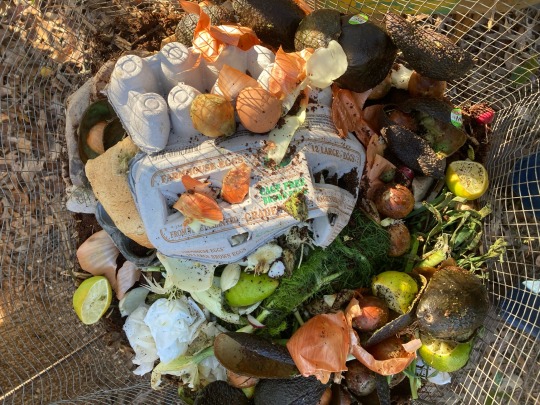
#compost#food systems#atlanta urban ag#food access#soil food web#soil health#food sovereignty#community composting systems#raised beds#vermicomposting#visionary growing solutions#maurice small
56 notes
·
View notes
Text

The garden is done. The fruits are done, except for a few "winter persistent" ones like ground cherry, persimmon, or rose hip. Last year's compost pile has been spread out on top, here, and my husband is going to till it in. Most of the leaves have been blown either off the yard into the wild edges or onto the flower beds, to rest over winter and provide nutrients to the soil next year. The chickens are completely delighted that the garden fence is down and there is an ample supply of bare dirt for them to scratch. There are tons of worms in there, so they are full and happy!
I want to transplant a cherry bush from the edge of the forest while it's dormant. The one I transplanted at the end of last winter absolutely THRIVED in its new home by the strawberry beds. It put on way more new growth than I expected for a transplant. Since that went well, I'll transplant the second one, and they can hang out together. I also need to mark 'bare spots' in the asparagus bed, so I can plant just a few more plants next spring.Most of what I planted last spring survived. Most. It was an ok year, give or take a disappointing carrot yield.
Next year's growing season seems so far away. But there is plenty to keep me busy until it comes.
#gardening#farmblr#gardenblr#gardeners on tumblr#garden#solarpunk#farm#harvest season#eat local#soil health#garden soil#composting
63 notes
·
View notes
Text
Herd of Bulls Headed to the Highlands to Recreate Effect of Ancient Auroch Oxen on Scottish Soil https://www.goodnewsnetwork.org/herd-of-bulls-headed-to-the-highlands-to-recreate-effect-of-ancient-oxen-on-scottish-soil/
#good news#environmentalism#scotland#bulls#soil#soil health#environment#science#nature#animals#climate change#conservation#climate crisis
15 notes
·
View notes
Text
So if mycelium is like the Wi-Fi and plants talk to each other, does that mean my house plants are lonely
#plants#plantblr#plantcore#houseplants#house plants#mushrooms#Mycelium#leaves#garden#gardening#forest#woods#nature#moss#witch#monstera deliciosa#alocasia#soil#soil health#soil science#soil testing#science#science question#plants are friends#science nerds#biodiversity#botany#botanical#botanic garden#botanist
16 notes
·
View notes
Text
I’m so overjoyed that I got to take part in the LA Compost gathering at @occidentalcollege today! It was incredibly insightful. Not only did I learn how to establish a compost hub, thanks to @zoomzoomferrari, but I also got to continue Message to Earth, a community art installation. Thanks to all that participated. It was an amazing and educational experience! #LACompost #MessageToEarth #OccidentalCollege #lacompost

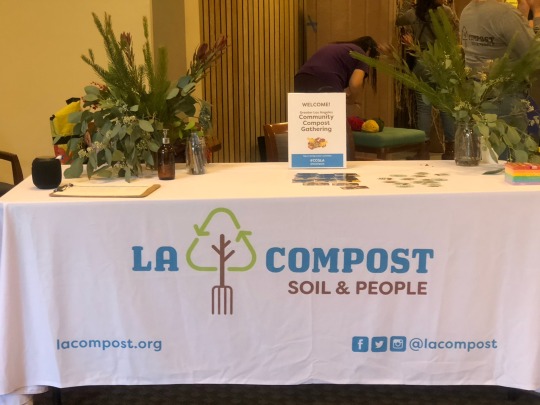
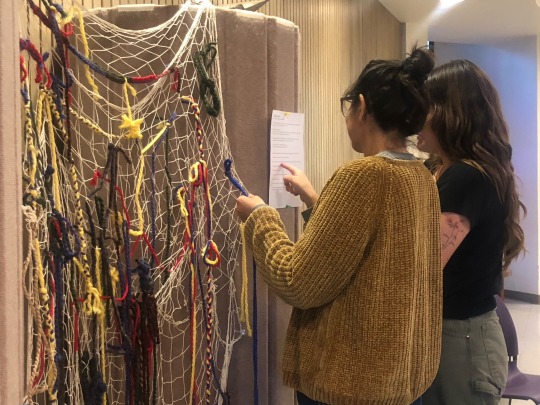
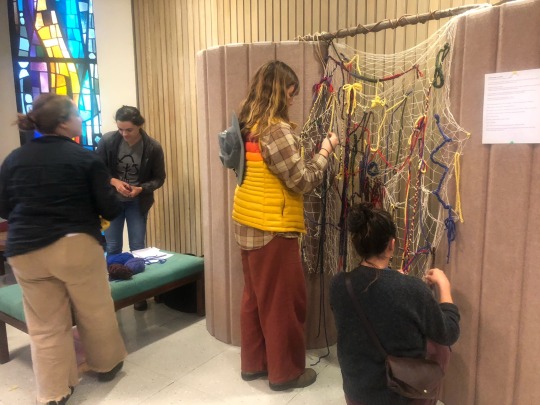
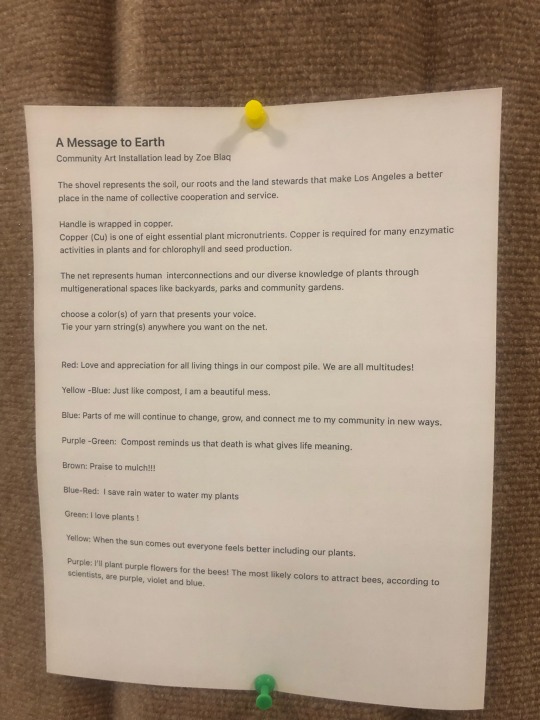
28 notes
·
View notes
Text
This photo is of 1/10th of the compost dug up for our garlic beds this winter.
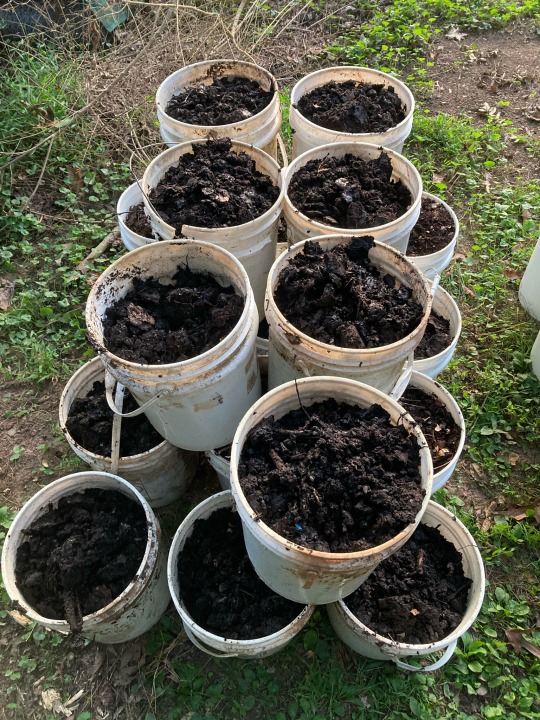
#compost#food access#atlanta urban ag#garlic beds#winter prep#bed preparation#food systems#soil health#food sovereignty#seed saving#garlic
40 notes
·
View notes
Text
Prepairing the soil for the indoor seedlings!
Yesterday, I put many seeds to germinate in a wet paper towel, and I've already used up all of the soil I had stored for spring plants, so, I had to go to the forest on a nice sunny day, and dig out some soil from under a dead stump. I only take soil from already dead and rotting trees, and only take a little, because that soil is now made out of tree-decomposing matter, which is very fertile, rich in nutrients, and basically compost quality. It's also very light and airy and that makes it possible to use in containers, all soil that is used in containers needs to be very light so that the baby plants can stretch their roots thru it.
Other than the forest, I'd been able to find such soil in the areas where the river has flooded and dumped massive amounts of tree leaves, which then decomposed for months, and again, have created compost.
I've planted my seedlings directly into the forest soil before, and they were growing just fine, then for a while I was mixing new forest soil, with already-used-up forest soil, and that was fine too! I also ran some experiments mixing soil with fine sand, and planting half of my seedling in soil+sand mixture, and half in only-soil, and they've both grown equally well, no difference was noticed.
This time, I'm going to mix my forest soil with already-used soil, which I have on my balcony, and I have a bag of fine sand from the riverbank. I'm making this mix because it will increase the amount of soil I can use, since I have a neck injury, it's complicated for me to bring home large amounts of soil home, and re-using soil is effective and easy, and perfectly fine if you add fertilized and nutritious soil in it.
You don't need to go thru this entire process just to grow plants, you can use store-bought soil, or try any kind of soil you have around until something works, I'm doing this just to increase the amount of soil I have and make sure it's easy to grow in!
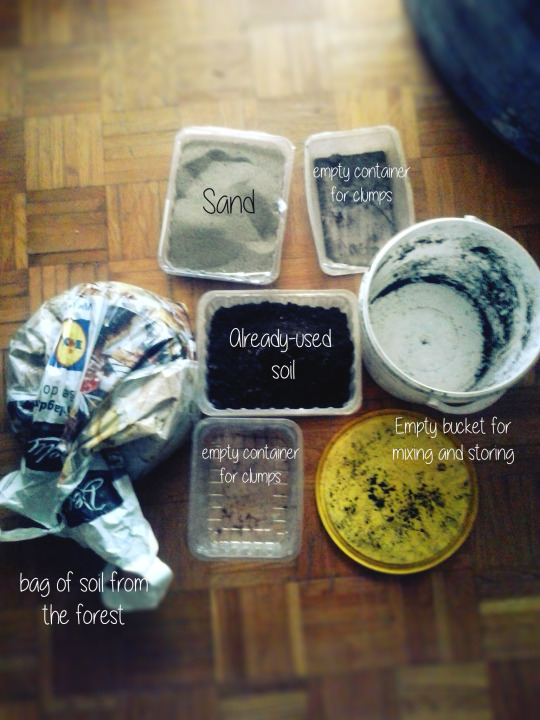
So I have forest soil, already-used soil, sand, and a bucket to put it all in. Before it gets in the bucket, I want to be meticulous and clean it, because even the already-used soil will have some hard clumps or pieces of bark or something, that might bother the tiny seedlings when they grow. I want to make it the most airy and productive soil ever. This is how the already-used soil looks after it's been clean.

And once it's nice and clean I dump it into the bucket! Now it's time to clean the equal amount of the forest soil, and this one is way more messy. There are leaves, roots, pieces of bark, rocks, seeds, sometimes there's even tiny little bugs I accidentally woke from hibernation, but they are fine and good for the soil, and they generally just keep living in the soil and don't go running around the apartment, so I don't mind them at all.
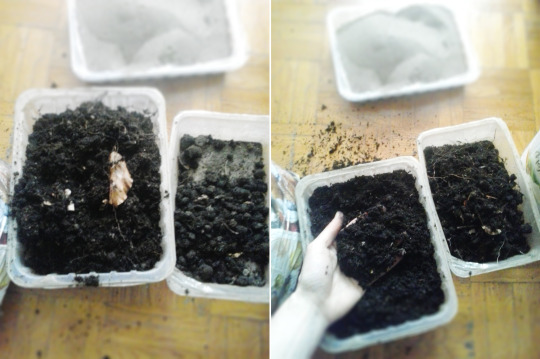
This is how it looks before and after I cleaned it, I was just brushing my hands thru and taking out anything that felt clumpy and odd. If you had a big sieve you could do this within seconds, but I like having my hands in the soil, so I was having a good time spending 10 minutes picking stuff out.
Now, both of the soils are added into the bucket, and I'm also adding sand in. Sand isn't going to add any nutrition to it, but it is very airy, very light, and very easy for little plants to push seeds thru. It will make the soil lighter, and increase drainage, means the water will run down more easily and the soil will not keep water inside. I've tried to make it about 20% sand.

And I'm loving the result after mixing! The soil is a tad more grey in color, but extremely light and airy, I think the plants are going to love it. It's a bit less filled with nutrients than the pure compost would be, but I will add nutrition when the plants become big enough to require it (when they have more than 1 set of true leaves).
All of the clumps, leaves, pieces of bark and clusters of roots I took out, can be composted, but, I'm going to actually use them for filling the big pots on my balcony. I usually add all of the clumpy soil at the bottom, because it adds more drainage at the bottom, and by the time the plants grow their roots all the way down, they won't be bothered by the clumps, it's only the most fragile tiny roots of baby seeds that are sensitive and need airy and non-clumpy soil.
Since my experiment with mixing went so well, I repeated the process and added once more, a container of used soil, container of forest soil, and a bit of sand, to make a full bucket of soil. Now I have plenty of soil to work with! I'm going to keep this bucket inside of my room, because those baby seeds are used to warm temperatures, and will want to be planted in warm soil. I'm also closing the lid, so the soil remains damp and full of life.
If your soil dries out, then the bacteria and diversity inside of it starts dying off, and it can even become hydrophobic! In case it does get so dry it starts rejecting water, it can still be rehabilitated, by adding more organic soil in it and mixing it all together. I've also seen gardeners add soapy water, because bubbly water has less surface tension and is more easily absorbed by the dry soil. For this purpose, they'd add a few drops of dish detergent in the water.
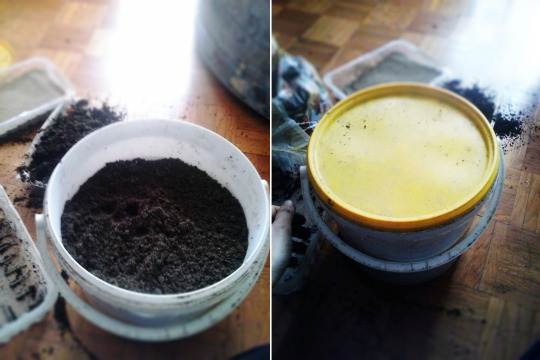
Here's my bucket of soil! This can fill many containers and cups, and when I run out, I have enough ingredients to make more. In a few weeks, I'll probably have to go to the forest to get some more, but I'll be all set until then.
#soil health#free soil for planting inside#soil mix#soil nutrition#compost#planting mix#diy inside soil#container soil#gardening#growing seedlings#growing transplants
91 notes
·
View notes
Text

Isopods, aka roly-polies or pill bugs, - tiny crustaceans with BIG impacts
They’re detritivores, meaning they feast on dead and decaying organic matter—like fallen leaves, wood, and even fungi. 🍂🥀🪵
Here’s why they’re vital for our soil:
🌱 Nutrient Recycling: As they munch through plant material, they break it down into smaller particles, speeding up the decomposition process. This enriches the soil with vital nutrients that plants need to thrive.
🔄 Carbon Cycling: By decomposing organic material, isopods play a key role in the carbon cycle, helping store carbon in the soil and reducing carbon loss to the atmosphere.
🌍 Soil Aeration: While burrowing and feeding, isopods loosen compacted soil, improving oxygen flow and creating a healthier environment for plant roots and microorganisms.
Found on every continent except Antarctica, isopods thrive in forests, gardens, and even urban environments. 🌟 Wherever there’s organic matter to break down, these hardworking decomposers are on the job!
So next time you see an isopod, give it some love! 🤍 They’re working hard to keep our soil alive and thriving. 🌿
#soil health#soil science#soil#permaculture#isopods#pill bug#roly poly#environmental education#environmental awareness#regenerative farming#regenerative agriculture#agriculture#sustainable living#sustainable farming#sustainability#organic life#organic matter#organic lifestyle#organic farming#organic#vermicompost#composting#compost lifestyle#compost#biodiversity#conservation#ecomindset#bugs#insects#nature lovers
71 notes
·
View notes
Text
Any form of poison, even rat or weed or bug poison, should be illegal to produce.
21 notes
·
View notes
Text

After the frost.
#compost#collard greens#atlanta airbnb agricultural experience#atlanta airb experience#visionary growing solutions#biodynamic#biodiversity#food systems#permaculture#soil health#soil#atlanta urban ag#tending to the herbs#simple food small farmz air bnb agriculture experience#simplefoodsmallfarmz#maurice small
9 notes
·
View notes
Text

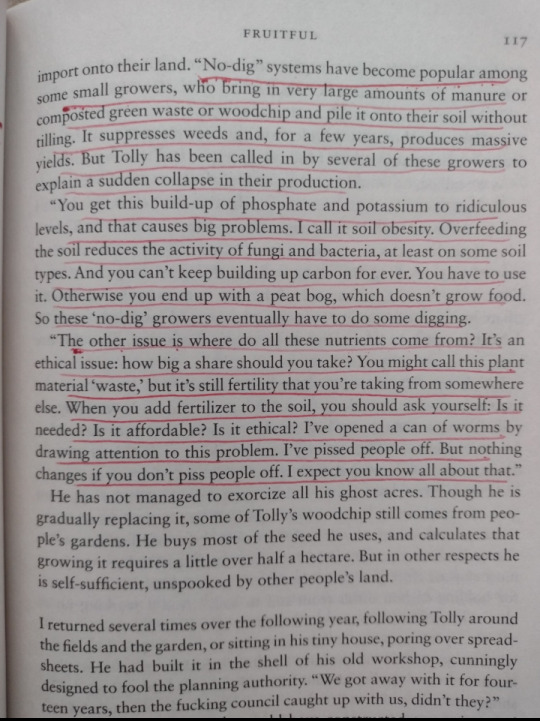
From Regenesis: Feeding the World Without Devouring the Planet by George Monbiot
27 notes
·
View notes
Text
Blessed to be able to use my gifts and talents.
#visionarygrowingsolutions

#compost#soil#permaculture#biodynamic#atlanta urban ag#urban ag#biodiversity#soil creation#worms#vermicomposting#lettuce#soil mechanics#soil moisture#soil health#food systems#food sovereignty#visionary growing solutions#onions#kitchen garden#mulch#maurice small
18 notes
·
View notes